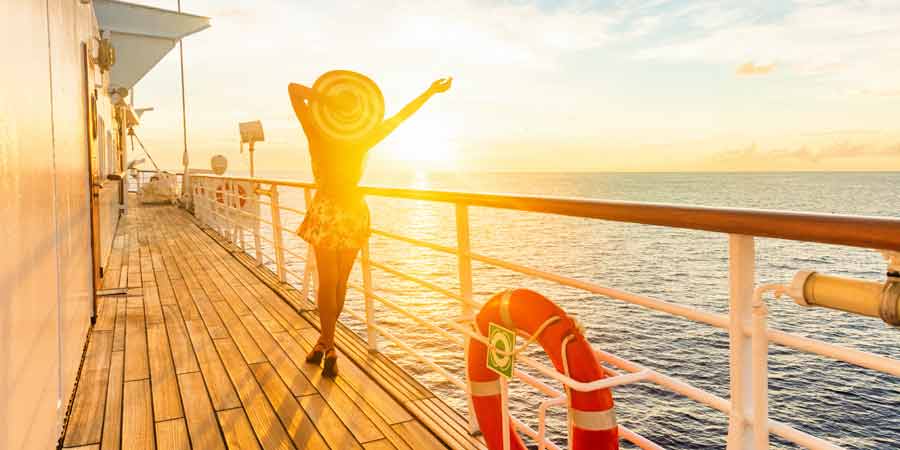
*Sourced from Cruise Critic
It's one of the most common cruising questions: When is the best time to cruise Alaska, Australia, the Caribbean, Canada/New England, Hawaii, Europe or the South Pacific?
The answer depends on many variables. For example, fall foliage enthusiasts will find September and October the best time to cruise Canada/New England, whereas families prefer to sail in summer when temperatures are warmer for swimming. The best time to cruise to Alaska will vary depending on your preferences for viewing wildlife, fishing, bargain-shopping, sunshine, warm weather and catching the northern lights.
For most cruise regions, there are periods of peak demand (high season), moderate demand (shoulder season) and low demand (low season), which is usually the cheapest time to cruise. High season is typically a mix of when the weather is best and popular travel periods (such as summer and school holidays).
However, the best time to cruise weather-wise is usually not the cheapest time to cruise. The cheapest time to cruise is when most travelers don't want to go because of chillier temperatures or inopportune timing (too close to holidays, the start of school, etc.). But the lure of cheap fares and uncrowded ports might make you change your mind about what you consider the best time to cruise.
As you plan your next cruise, you'll want to take into consideration the best and cheapest times to cruise and see what jibes with your vacation schedule. Here's a when-to-cruise guide for popular destinations.

Alaska: June - August
Alaska has a very short cruising season; ships traverse its northern waters only between May and September. The months of June through August offer the warmest weather (50 to 70 degrees Fahrenheit) in this chilly state and are therefore the best and most popular times to cruise. In May and September, you'll find some closures and a bit more chill in the air (high 50s to 60s), but you'll also find the best prices. In addition, May is the driest month of the Alaska cruise season, so you're less likely to be rained out of your flightseeing tour, glacier walk or other shore excursions.
To minimize joining the masses, select a ship that sails during the week. For a pricing advantage, northbound glacier routes tend to be cheaper than southbound.
Asia: November - March
Because the summer months of June and July (low season) bring the most rain and oppressive heat and humidity in Asia, the best time to cruise in terms of weather is November through March (high season). However, that's also when you'll find the highest prices and the most crowds at major attractions in the ports on Asia cruise itineraries. You'll find slightly less favorable weather -- but also fewer people and less expensive fares -- in shoulder season.
Australia: Late November - March
Australia's high season is late November to March. Winter in North America is summer in Australia, so expect near-perfect conditions in major ports of call like Sydney, Adelaide and Perth on the western side and a subtropical climate in the northeast Queensland region. It's also typhoon season, however, which may affect some ports of call (such as Brisbane and Cairns) and lead to some rough sailing waters. Aussies often vacation between late December and late January, so expect big crowds and jammed ports during that time.
While Australia's climate varies widely, winter temperatures are rarely extreme; crowds are fewer, and there are bargains to be had, especially on larger ships and Great Barrier Reef cruises that are available year-round. The downside: Expedition cruises and sailings to Tasmania are often limited during the rainier months of June, July, and August
Bermuda: June - August
Bermuda cruises sail from April through mid-November, mostly during Bermuda's high or "beach" season. Most people travel during the summer months (June through August), making those voyages pricier, but you'll find deals on spring and fall departures (April through early June and September through November).
Bermuda has temperate weather year-round and is less affected by hurricanes than its Caribbean neighbors. If it's too chilly for the beach in the shoulder season, you can always try out the island's many golf courses and spas. October tends to be the rainiest month. Bermuda's big weather caveat: Hurricane season traditionally affects the island at least once a year between late August and October. May is your best bet for shoulder season travel.
Canada/New England: September and October
Canada and New England sailings depart from May through October. You've got a better chance for warm weather if you travel from late June through early September. However, if you prefer more crisp weather (temperatures in the 50s) or you're interested in fall foliage viewing, you'll need to go from late September to mid-October.
May and late-October sailings will offer the lowest rates, but don't expect to be using the onboard swimming pool much. Meanwhile, the summer months are ideal for exploring some of Canada's most intriguing cities in milder temperatures (usually in the 70s).
Caribbean: December Through Mid-April
You can sail to the Caribbean year-round, but the best time to go is when it's coldest in the Northern Hemisphere. Not only is the warm Caribbean climate a welcome respite from bad weather, but December through April are the driest months in the islands as well.
The cheapest times to cruise are typically in the late summer and fall because of hurricane season, but you can often find patches of bargain sailings, especially during the early weeks of December and in the spring. The timing of spring discounts isn't always consistent, so it's best to keep an eye out and book when you see a low rate. If you dislike crowds or large numbers of children, avoid sailing late June through August or during school break times (late December, early January and March through mid-April).
Europe: April - June, September - October
Europe is so big that you can't lump all its cruises together. The Western Mediterranean cruise season runs from April through November, with a few European lines staying the course through the winter. The warmer Eastern Mediterranean and Greek islands, as well as the Canary Islands, see cruise ships between April and December, with a sprinkling of winter cruises from select lines.
Northern Europe and Baltic cruises have a shorter season, running from April to October, with Viking and Hurtigruten offering Northern Lights sailing January through March.
Most tourists come to Europe in the summer, but the late spring and early fall have more pleasant temperatures and not as many crowds. You'll find the lowest cruise prices at the beginning and end of each season; prices rise dramatically for the summer months.
You might find restaurants and other establishments closed in August, which is when much of Europe goes on holiday. September is a popular time to cruise the Western Mediterranean because you can avoid the school kids and still enjoy warm temperatures. Note that March and November can be rainy.
Europe Rivers: May - September
Europe's main river cruise season runs April through October, but peak sailings are May through September. Spring can mean flowers in glorious bloom. (Favorites are the spring Tulip Time cruises through the Netherlands and Belgium.) However, keep in mind that heavy rains and early-spring flooding can make the rivers swell and the locks impassable.
Conversely, summer temperatures can cause the rivers to dry up, making it impossible for boats to move. If these weather events happen, you'll be taken to the sights by motor coach.
River cruise itineraries are not weather dependent, so an offseason sailing means you get to enjoy the castles, cathedrals and quaint shops without the summer crowds. Many river lines also offer Christmas market cruises in November and December to Germany, Austria, and Eastern Europe.
Hawaii: Late December - April
High season in Hawaii is late December through April, but with Norwegian's Pride of America based there, you can explore the islands year-round. The best time to go is during the summer and fall, when the island gets the least amount of rain. Summer tends to be popular because of school vacation and honeymoon season. Hawaii cruises are cheapest from November through February, with the exception of holiday cruises.
If you're considering a summer cruise, note that seas can be rough in August. Hurricanes rarely affect the islands, but they come closest in September, bringing hot, humid weather, despite it being the dry season. They can also kick up storms that lead to rough seas and less-than-ideal excursion conditions.
Good deals are often available in the less-traveled window between Thanksgiving and Christmas vacation. Late September and October can also see a large selection of cruise ships visiting the islands, as ships tack on Hawaii cruises after the end of the Alaska season and before transiting to their next seasonal homeport.
Mexican Riviera: February Through Mid-April
You can cruise to Mexico year-round, either as part of a Western Caribbean itinerary or as a dedicated Mexico voyage. The best time to visit Mexico is during its dry season, November through May. However, it's a popular destination even during the rainier summer months. You'll find the best deals in the fall, between the two high seasons and during hurricane season.
In early spring, the weather is dry, with temperatures in the 70s and 80s, making it a popular escape for Northerners, and February and March are prime whale-watching months. On the negative side, college-age youths often cram into port destinations like Ensenada and Puerto Vallarta at this time, creating a wild and boisterous atmosphere. During off-peak months, there are fewer crowds and a more adult atmosphere, but the weather can also be unpredictable, with temperatures dropping as low as the 40s.
South America: November - March
The high season (November through March) occurs during South America's summer, but be prepared for varied climates that can change rapidly wherever you go. The warm mid-70s temps you're enjoying could become the windy, rainy low 40s in the blink of an eye. Plus, when it's steamy in Buenos Aires, it can be quite chilly in ports like Punta Arenas and Ushuaia. Although you can expect crowds of South Americans on vacation, you can find high-season bargains in the weeks between Thanksgiving and Christmas.
High season is pretty much year-round in the Galapagos Islands, where the warm and tropical climate is relatively unchanging. However, those prone to seasickness should avoid August and September, when waters can be choppier.
Tahiti/South Pacific: May - October
The South Pacific's high season (May through October) actually occurs during the winter months. At this time, the weather is more favorable, as it rains less frequently and there's a reduced possibility of tropical cyclones (though the strongest trade winds usually kick up at this time, too). The region's dry season dovetails nicely with wedding season and school summer holidays, making cruises popular with honeymooners and European and American families on extended vacations.
The South Pacific's summer (November through April) is the wettest time of year, when rain, temperatures and humidity increase. However, prices are significantly lower, and water temperatures are still perfect for swimming. March and April tend to get less rain than earlier in the summer season. The South Pacific is a popular cruise destination for Australian families. Expect higher prices and plenty of kids onboard if you cruise this region during Australian school holidays.















